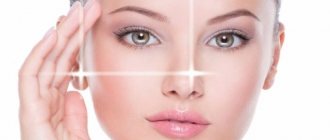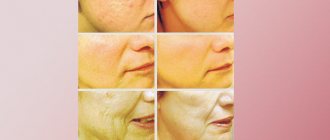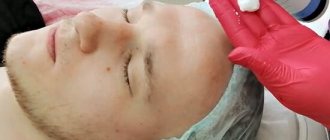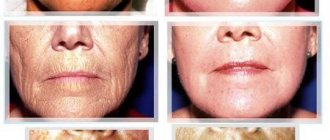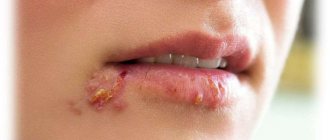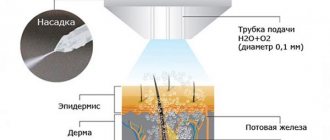You can activate the mechanisms of self-rejuvenation of the skin through various aggressive cosmetic procedures that remove the top layer of the skin. This technique is acid peeling, which causes a burn of the epidermis. In this article we will tell you how it is performed, what is its effectiveness, who is contraindicated, what to consider during the rehabilitation period and other important information.
Acid peeling involves removing the top layer of skin using a chemical compound.
What is salicylic facial peeling?
Salicylic peeling is a type of cosmetic procedure in which salicylic acid of varying concentrations (beta-hydroxy acid) is used as an active agent.
Its derivative is the substance LHA, which works in a similar way, but more gently. Both components are actively used both in store-bought products and in formulations for home procedures.
Compound
Salicylic peeling rolls usually contain:
- Salicylic acid;
- Fruit acids;
- Lactulose;
- Cosmetic fragrance.
The main active substance is salicylic (phenolic) acid. It has excellent anti-inflammatory and antiseptic properties. They learned to extract it from flowers of the rose family. This substance has found active use in the pharmaceutical industry, medicine and cosmetology.
Mechanism of action
Phenolic acid destroys protein bridges that connect the cells of the stratum corneum of the skin. As a result, it exfoliates. In addition, the substance has a bactericidal effect and makes the complexion lighter, which is important in the presence of age spots and acne marks.
Difference from other peelings
Being an excellent keratolytic, phenolic acid not only exfoliates a layer of dead cells, but also causes the division of new ones. Most acids have this ability, but salicylic acid has its own characteristics. It significantly reduces oil content due to a chemical reaction with sebum and deep penetration into sebaceous plugs.
The essence of the technique
Acid peeling comes from the English verb to peel. It is translated as “scraping,” and scraping is the meaning and essence of this cosmetic procedure. It can be used for the face, abdomen and other parts of the body (if the course is agreed upon with a cosmetologist).
To understand the mechanism of action of the procedure, let's turn to anatomy - it is important to understand what our skin is made of.
The skin “in section” looks like this:
- The top layer is called the epidermis. This is the thin, outer skin where all vital processes take place: cells grow, work, die, metabolic processes “boil”, the immune system works, which protects us from harmful bacteria and pathogenic microorganisms.
- The second layer is called the dermis. If you imagine it in the form of a ball, you get two: papillary and reticular. The balls contain collagen and elastin, which are responsible for the smoothness and elasticity of the skin.
- The last layer is fatty tissue. Between the fibers are fat cells. They protect a person from temperature changes, overheating or hypothermia.
All layers tend to renew themselves naturally, literally being reborn anew. Now let’s figure out how exfoliation, that is, peeling, renews the skin layers.
Indications for use
The facial peeling procedure with salicylic acid, like any other salon procedure, has contraindications. Therefore, it is recommended to use it only after consultation with a dermatologist and in the presence of serious skin problems.
What skin types is it suitable for?
Cosmetologists recommend using salicylic peeling for oily skin prone to increased sebum production and the appearance of comedones and pimples. For dry, sensitive and even normal types, this procedure may be too aggressive.
What problems will it help solve?
Salicylic peeling - indications for use:
- Seborrheic dermatitis;
- Acne I and II degrees;
- Presence of acne and skin rashes;
- Tendency to increased sebum production;
- Hyperkeratosis;
- Folliculitis;
- Acne marks, shallow scars;
- Earthy skin color;
- Enlarged pores;
- Dark spots;
- Age-related changes;
- Photoaging.
Contraindications and side effects
Chemical salicylic peeling should not be done if you have the following health problems:
- Diabetes;
- Herpes in an advanced stage;
- Cuperosis;
- Inflammatory processes;
- Violation of the integrity of the skin, including burns and cuts;
- Use of glycemic drugs;
- Possible allergic reactions;
- Increased sensitivity to peeling components;
- During pregnancy and during breastfeeding.
Cosmetologists recommend paying attention to your skin type before performing the procedure. For women who are very sensitive, it is better not to exfoliate during periods of increased solar activity and postpone it until the autumn-winter period or warm cloudy weather.
Side effects
Redness, peeling, and swelling are a normal skin reaction to the procedure. Unpleasant phenomena will pass within a week. Sometimes burns may occur during the peeling process. It manifests itself in the form of pigmented areas in the damaged area.
Acid peeling has virtually no side effects. But still, like any other procedure, it must be treated with due attention and caution. Despite the safety of such a procedure, it should only be performed by an experienced specialist.
Types of salicylic peeling
The action of chemical peeling with salicylic acid of varying concentrations is aimed at eliminating serious skin imperfections. It is recommended to choose the appropriate type only after consultation with an experienced cosmetologist.
Surface
The superficial type of salicylic exfoliation is more gentle. During the procedure, formulations are used in which the content of the active component does not exceed 10-25%, and the pH of the product is at the level of 2.0–3.1.
The main objectives of superficial peeling are:
- cleansing problematic skin prone to increased sebum production;
- removal and prevention of acne and comedones;
- correction of facial wrinkles;
- even out complexion;
- elimination of pigment spots.
Median
The middle type is carried out using a more concentrated solution of salicylic acid. The content of the active component is at the level of 20-30%, and the pH is 1.1–1.9.
This type of exfoliation is designed to solve the following problems:
- deep wrinkles;
- age spots and uneven complexion;
- post-acne;
- loose skin;
- pronounced aging processes.
How does the procedure work?
The protocol for salicylic peeling is strictly regulated. It includes not only several stages of the procedure, but also a preparatory stage.
A few weeks before visiting the salon, it is not recommended to visit saunas, solariums and baths, use scrubs and gommages, so as not to thin the top layer and not cause microtraumas from abrasive particles. You should not use formulations with zinc or resorcinol, which are not compatible with the active component of the peeling.
Cosmetologists say that a course of salicylic peeling can be done in the summer. But before each trip outside, you need to apply a cream with a high level of UV protection every day.
The doctor may also prescribe preliminary use of products containing a small amount of salicylic acid (no more than 2%) so that the skin can better adapt to the upcoming peeling. Exfoliation to get rid of pigmentation will require the additional use of creams with arbutin or kojic acid.
Cleansing and makeup removal
The peeling procedure consists of several stages, the first of which is the removal of makeup residues and surface impurities using cleansing milk or foam. This is necessary so that the composition penetrates better into the top layer.
Toning
Then the skin must be rid of excess sebum using a tonic or lotion with antiseptic properties. This will prevent the growth of bacteria on the surface and prevent the inflammatory process.
Peeling
The salicylic peeling procedure is not particularly difficult. The product is evenly distributed on the appropriate area using cosmetic discs. In this case, the number of layers and duration of action are determined by a specialist, taking into account the individual characteristics of the skin.
Neutralization
An important advantage of the salicylic acid peeling procedure is that it does not require a special neutralizing composition. Washing with clean, cool water is sufficient.
Moisturizing and soothing the skin
To consolidate the result, apply a wound-healing and regenerating mask to the area treated with the product for a quarter of an hour. In addition, to prevent negative consequences, it is recommended to stay at home for several days after the procedure so as not to expose the skin to adverse environmental factors.
How is acid peeling performed?
Exposure to acids is a procedure that requires special attention and accuracy. After all, if you make a mistake with the acid concentration or exposure, the consequences can be quite unpleasant. The peeling algorithm is quite simple and does not take much time:
Stage I: Preliminary cleansing of the skin from makeup residues, degreasing it.
Stage II: Applying the peeling mixture.
The required acid (or mixture of acids) is applied to the cleaned surface in a thin layer and left for some time. The process of applying the mixture may be accompanied by a tingling or slight burning sensation. It is this stage that requires careful monitoring. If the patient experiences atypical reactions to the applied substance or the exposure time has expired, proceed to the next step.
Stage III: Neutralization.
The effect of the peeling agent is neutralized by a special solution, which also moisturizes and tones the skin after the exfoliation session.
Stage IV: Post-peeling measures
After an acid burn, the skin needs special care. Following the neutralizer, a special cream is applied to it, which has a stimulating effect on regenerative processes.
Video
Salicylic peeling at home
Salicylic acid exfoliation can be done at home. The main thing is to strictly follow the recipe and the basic rules of the procedure.
What is the difference from a salon procedure?
Homemade salicylic peeling is considered more gentle, because it does not have such a wide range of contraindications as salon procedures, but the results will be more modest. It should also be remembered that such a procedure should not be carried out on overly irritable and dry skin.
What result to expect
After a salicylic peel performed at home, you should not expect the same effect as from a salon procedure. However, you can count on the fact that problematic skin will clear up and get rid of inflammation, and the area affected by acne will become much smaller. With regular comprehensive treatment, over time you can completely get rid of acne, even out the top layer of skin, make the surface matte, smooth, and make pores less noticeable.
Possible complications
Cosmetologists do not recommend exfoliation containing salicylic acid on your own, because after the procedure various complications may appear:
- the appearance of a feeling of tightness, burning, peeling and redness;
- skin dehydration;
- the appearance of swelling and inflammatory processes in the treated areas;
- allergic reaction;
- exacerbation of herpes.
As a rule, the consequences of the procedure at home disappear after a few days. If this does not happen, you should consult a dermatologist.
General rules for use at home
Making salicylic peeling at home is not so difficult, but this does not apply to professional salon procedures. It should also be remembered that it is necessary to add emollient components to the composition of peeling products based on acetylsalicylic acid, which will help reduce the aggressive effect on the skin.
It should be borne in mind that aspirin can cause a burn of the epidermis and cause various unpleasant sensations if the skin is too dry.
Execution technique
This effect on the skin is carried out in several stages:
We recommend: An effective procedure for skin renewal - ABR peeling. Features of the event
- Preparation. First, the skin is cleansed using soft foams or mousses to remove dirt and skin secretions. Then the surface to be treated is degreased with a special compound or lotion. They can also apply a gel with weak acids to prepare the skin for more intense effects.
- Application of the main active composition. There are differences in this stage of peeling depending on its type:
- If this is a chemical peel, then the active product is distributed over the skin either with light movements, which has a more gentle effect, or by rubbing it into the surface with a cotton pad to enhance the effect. The product is kept on the skin for a certain time, depending on the active substance and the condition of the skin.
- When performing mechanical peeling, an abrasive agent is applied to the face, and the skin is massaged with light circular movements of the fingers or a special brush.
- Neutralization. After removing the cleansing composition, apply a product that normalizes the acid-base balance of the skin and remove it with warm water.
- Recovery . A soothing mask is used to relieve inflammation after intense exposure or moisturizing compositions with hyaluronic acid, alginates or amino acids.
Recipes for salicylic facial peeling at home
You can prepare salicylic peeling at home yourself using proven recipes. There are a large number of home remedies and methods that use additional ingredients that have beneficial effects on the skin.
For dry skin
The dry type, prone to irritation, needs more gentle formulations. To prepare the product, you need to crush two tablets of acetylsalicylic acid and add to them the yolk and a spoonful of sour cream. Treat the skin with salicylic alcohol, apply the product in a thick layer for 10 minutes, without rubbing. Wash off with warm water and baby soap. To achieve greater effect, 6 to 8 similar procedures will be required.
For oily skin
The recipe for correcting the imperfections of oily skin is very simple. You will need to mix the powder of two aspirin tablets with a tablespoon of water, and add aloe vera gel as a thickener. First, the skin must be degreased with a solution of salicylic alcohol, and then apply the mixture for 8–10 minutes with light massage movements. Rinse off the mask with cool water and lubricate your face with moisturizer.
The permissible number of cleanings per week is no more than two. The total number of procedures is 10.
Rejuvenating
Banana-salicylic facial peeling at home is suitable for aging skin that lacks nutrients. It is prepared from 4 crushed aspirin tablets, yolk and a small amount of banana pulp. The mass is applied to the face with a brush and left for several minutes, after which it is removed with cotton pads soaked in a soda solution.
After this procedure, the skin looks more radiant and youthful. After 8-10 procedures, some age-related deficiencies can be corrected.
https://youtu.be/Hoc3bQBmYMg
With herbs
Salicylic exfoliation based on herbal decoctions is a superficial procedure. The main advantage of this type of peeling is its gentle effect, so the likelihood of a burn is very low.
To prepare herbal infusions, cosmetologists recommend using chamomile and calendula. These plant components normalize skin condition and reduce the tendency to irritation.
Chamomile is famous for its anti-inflammatory properties, and peeling based on it helps get rid of the unpleasant feeling of skin tightness. To prepare you need:
- Prepare a chamomile infusion by pouring one tablespoon of the herb into a glass of boiling water.
- Let the mixture brew for 20 minutes under the lid and strain.
- Grind one tablet of acetylsalicylic acid.
- Mix aspirin with one tablespoon of broth.
- Add a teaspoon of rich face cream and stir.
- Apply to skin.
- Massage with your fingertips for 2-3 minutes.
- Wait 5 minutes.
- Rinse off with warm water.
Calendula has equally beneficial properties and helps fight acne and blackheads, and heals small wounds. To prepare the medicinal composition, you will need dried calendula flowers, which can be purchased at the pharmacy.
Instructions for preparing the product:
- Grind the acetylsalicylic acid tablet.
- Add a tablespoon of decoction and a small amount of starch to the powder to obtain a paste-like consistency.
- Apply the composition to the skin.
- Rub thoroughly over entire face, paying special attention to problem areas.
- Wait a third of an hour for the components to penetrate the top layer, rinse with warm water.
With egg
Cosmetics containing chicken eggs help enrich the skin with beneficial microelements. However, peelings made on their basis have a rather aggressive effect on the skin due to the high concentration of the active component. Therefore, with their help you can remove even small scars and refresh your face. Depending on the condition of the skin, you can add cream or cinnamon to the product.
For those who want to improve their complexion, you will need a product with cinnamon. It not only improves skin tone, but also improves metabolic processes in the deep layers and increases blood circulation.
The composition is prepared from 4 crushed aspirin tablets, yolk and a teaspoon of cinnamon. Apply the product to the face and gently massage the skin for 5 minutes. The same amount of time should be allocated for more thorough absorption of the composition. Wash off the drug with a weak solution of soda, and then carefully rinse your face with clean water.
If your skin is prone to dryness and flaking, you can use a universal recipe for chemical exfoliation with cream. To prepare, you will need a powder made from 4 tablets of acetylsalicylic acid, a small chicken egg and 20 mg of heavy cream. The components must be whipped until fluffy, applied to the skin with a brush and wait 5-7 minutes. When rinsing with soda solution, massage your face with your fingertips.
With aloe
Aloe has been famous for its beneficial properties since ancient times, so peeling, which contains the juice of this plant, has an antibacterial and wound-healing effect.
To prepare the composition you should:
- Remove the skin from two small leaves of the plant.
- Rub them through cheesecloth until they become a thick jelly.
- Add 1 tablet of acetylsalicylic acid and a teaspoon of coffee grounds to it.
- Dilute slightly with water.
- Apply to skin with light massaging movements.
- Leave for 4 minutes.
- Wash off with chamomile infusion.
- Cleanse your face with milk and toner.
Honey
The honey peeling recipe is considered basic. This procedure helps to minimize age-related changes and saturate the skin with beneficial microelements.
To make it you will need two tablets of aspirin, which must be ground to a powder, and two tablespoons of honey. To prevent the mass from being too thick, it is necessary to dilute it with a small amount of water.
The product is applied to the skin for 5-10 minutes and then washed off with water. When washing, it is recommended to lightly massage the skin with your fingertips.
Intensive with aspirin and lemon
Peeling with salicylic acid at home with lemon juice is considered one of the most concentrated and harsh. To prepare you need:
- Crush 4 aspirin tablets.
- Mix the powder with two yolks.
- Add a teaspoon of lemon juice and beat the mixture until foamy.
- Apply the mixture to your face with a brush and wait 7 minutes.
- Rinse off with a cotton pad soaked in a special solution. It is prepared from 150 ml of warm water and two teaspoons of baking soda.
- Wash with warm water.
Recipe from model Shelley Barrett
Australian model Shelley Barrett uses a beauty product with aspirin to prevent redness and inflammation and add radiance to the skin. To prepare the peeling composition, she crushes one aspirin tablet and mixes it with melted honey. The composition must be kept for at least 10 minutes and then rinsed off with warm water.
What types of peeling acids are there?
Fruit peeling involves the use of special acids, the effects of which are similar, but slightly different:
- Glycolic acid – has increased activity and easily penetrates the skin. It is obtained from sugar, beets or green grapes. Great for combating pigmentation and poor complexion.
- Lactic acid – found in tomatoes, blueberries and foods such as kefir. A more exotic supplier is maple syrup. Used to increase the level of moisture in the epidermis, as well as to normalize the shade.
- Malic acid is extracted from the fruit of the same name and is aimed at increasing metabolism in every cell of the epidermis.
- Tartaric acid – extracted from grapes and oranges, has unsurpassed whitening and moisturizing properties.
- Citric acid – ideal for the skin of women over 30, contains antioxidants and promotes rejuvenation, as well as whitens and kills bacteria.
There are a number of other fruit acids found in fruits such as pomegranate or pineapple. But they are used somewhat less frequently.
Acids are included in cosmetics in different proportions; it is important to choose products for home use that clearly indicate what skin they are intended for and what problems they solve.
Home peels have a superficial effect and are intended for regular use. With their help, you can protect dry skin from gray color, wrinkles and flaking, and oily skin from acne, large pores and greasiness. The whole process does not take much time and is quite effective.
Acid peeling in salons can be deeper, but it should only be carried out by a professional. It is necessary to take into account all indications and contraindications, since salons use professional preparations that are dangerous to skin health if the concentrations are incorrectly selected.
How to care for your face after the procedure
The effect of salicylic peeling on the skin can be compared to a chemical burn. The degree of damage is related to the concentration of active components, skin type and individual characteristics of the body. Therefore, this method of skin treatment must be used with extreme caution.
Feelings after the procedure
At the end of the procedure, you may feel a slight burning sensation and tightness, and notice redness, which sometimes becomes more pronounced after a few days. To avoid these unpleasant sensations, you should use care products recommended by a cosmetologist.
After some time, exfoliation of the stratum corneum, consisting of dead cells, will be observed. During this period, it is important not to expose the skin to mechanical friction and exposure to ultraviolet radiation.
At the third stage, the skin becomes more elastic and smooth. Small wrinkles are smoothed out, and deep ones become less noticeable.
Prohibitions during the rehabilitation period
After using peeling with salicylic acid at home, you need some time for rehabilitation. This is necessary so that the recovery processes are more active. On average, it is recommended to spend about a week on this.
During this period, you should not visit baths, gyms, swimming pools and saunas or go outside without first protecting your skin with sunscreen (especially on summer days). We must not forget to apply ointments with panthenol to the skin, as well as other caring soft cosmetics. It is also strictly forbidden to remove dry crusts that have formed.
Ready-made products for use at home
You can experience the positive properties of salicylic peeling without leaving your home. Among industrial products, the most popular is “Corrective care against imperfections, 24 hours of hydration”, Normaderm, Vichy. It contains LHA and 1.5% salicylic acid, which help gently eliminate imperfections in problematic skin. The product has a mattifying and moisturizing effect.
The line of such preparations includes a lotion for reducing and preventing skin imperfections, Breakout Control Blemish Treatment Facial Lotion, Kiehl's. In addition to the active ingredient, it contains vitamin B3, which helps make the skin clearer and smoother.
No less beneficial for the skin is the “Clean Skin” cleansing tonic against blackheads and oily shine from Garnier, which makes pores narrower. Effaclar, La Roche-Posay pore tightening lotion has the same effect; it is hypoallergenic and suitable for sensitive types.
To get rid of acne, you should use the ultra-cleansing gel “Clean Skin. Active" against acne from Garnier. It features a built-in soft bristle brush and also contains beneficial blueberry extract. It is recommended to eliminate oily shine using the corrective emulsion Effaclar K(+), La Roche-Posay.
To correct wrinkles, a cleansing gel for skin with imperfections and age-related changes is suitable: Blemish and Age Cleansing Gel, SkinCeuticals. It contains glycolic acid, which gently exfoliates dead cells.
Causes of possible complications
If after the procedure you experience discomfort and negative changes, then you may be allergic to salicylic acid. You must not violate the rules of the rehabilitation period and try to remove the crusts formed on the surface mechanically; you can seriously harm the skin. In this case, acne and pimples are likely to appear in their place.
Useful properties and advantages of the procedure
Salicylic peeling has certain pros and cons.
Advantages and useful properties:
- availability;
- versatility;
- Pronounced anti-inflammatory and antibacterial effect;
- Lightening effect;
- Normalization of the sebaceous glands;
- Possibility of safe contact with fruit acids and other beneficial components;
- Limited list of contraindications;
- Prevention of the appearance of blackheads due to the keratolytic effect of the product;
- Correction of visible imperfections and age-related changes without surgical intervention.
Characteristic
Peeling – what is it? This is a procedure through which the layer of rough skin is exfoliated. At the same time, old dying cells are removed, and the top layer of the skin is renewed. As a result, the skin becomes clearer and looks much younger. Chemical peels use different acids. Peels with fruit acids or alpha hydroxy acids (AHA) are especially popular.
This procedure was used in Ancient Greece and Ancient Egypt. For rejuvenation, they used wine lees, which contained tartaric acid, and sour milk, which contained lactic acid.
And today, such affordable and safe recipes have not been forgotten that can change the appearance of the skin for the better, without using various injections and new techniques.
During a chemical peel, the problem area of the skin is burned. However, the specialist controls the depth of penetration of the burn, after which skin restoration processes begin to take effect. As a result, skin problems are eliminated, while at the same time its rejuvenation occurs. After the procedure, rapid cell division occurs in the skin. This makes the skin texture smooth and the color even. Before and after you can see a big difference, as in the photo

